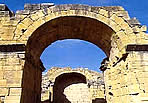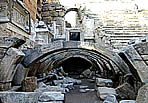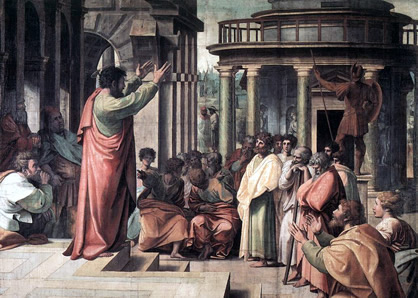Hierapolis Col. 4:13
A few miles north of Laodicea in the Lycus Valley, the ruins of
Hierapolis stand along the ancient roadway connecting Laodicea to
Philadelphia and Sardis to the northwest. The ruins dem onstrate
it was a prosperous trade center built around hot springs that were
considered a source of healing power in the Roman period.
onstrate
it was a prosperous trade center built around hot springs that were
considered a source of healing power in the Roman period.
In the southwestern edge of the Phrygian territory, the city is
perched 250 feet above on a natural terrace overlooking the
surrounding valley. The ancient city had all the drawing points of a
resort, with all the regional goods of the other regional cities:
wools, dying trades and textiles.
With hot thermal springs ever present and cool mountain air to offer
cold water constantly available, the dying guilds no doubt made use
of these natural features required in adding color
 to
cloth. The city also had an advantage in the bath complex, still
seen on the northwestern part of the citys edge, near the northern
necropolis. Some scholars compare the hot water of Hierapolis, and
the cold water of Colossae to the lukewarm water of Laodicea as the
background for the imagery of Rev. 3:15-16.
to
cloth. The city also had an advantage in the bath complex, still
seen on the northwestern part of the citys edge, near the northern
necropolis. Some scholars compare the hot water of Hierapolis, and
the cold water of Colossae to the lukewarm water of Laodicea as the
background for the imagery of Rev. 3:15-16.
Hierapolis was not a great city of antiquity, but was likely a pagan
cult center as demonstrated in the name, which means holy city. A
Hellenistic theatre demonstrates the city existed well before the
earthquake of 17 CE, when Augustus supplied some aid to restoring
the city.
Inscriptions show there was a significant Jewish presence in the
city. Another damaging quake came in 60 CE, affecting the Lycus
cities, and requiring aid from Emperor Nero. The city may ha ve
been reached by St. Pauls ministry impact from Ephesus (Acts
19:10), but more likely came under the evangelistic preaching of
Epaphras (cp. Col. 4:12-13; see Laodicea and Colossae).
ve
been reached by St. Pauls ministry impact from Ephesus (Acts
19:10), but more likely came under the evangelistic preaching of
Epaphras (cp. Col. 4:12-13; see Laodicea and Colossae).
Stoic philosopher Epictetus stayed in the city for some time, as did
Papias. Polycrates, Bishop of Ephesus (190 CE) is quoted by Eusebius
(Church History 3.31) as stating that the Apostle Philip was buried
in the city, though scholars debate whether the reference is to the
Apostle or the evangelist.
The site today includes two partially restored ancient baths (north
and south of the city), an impressive colonnaded street, a Temple of Apollo and the
Martyrium of St. Philip. The nearby hot springs at Pamukkale, or
cotton castle (named because of the white calcified hot springs) are
not to be missed!
an impressive colonnaded street, a Temple of Apollo and the
Martyrium of St. Philip. The nearby hot springs at Pamukkale, or
cotton castle (named because of the white calcified hot springs) are
not to be missed!
Biblical Sites in Turkey List


